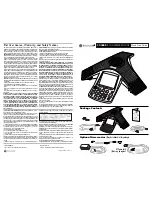
202
APPENDIX
* In the United States and Canada, the SAR limit for mobile phones used by the public is 16 watts/kg
(W/kg) averaged over one gram of tissue. The standard incorporates a substantial margin of safety to
give additional protection for the public and to account for any variations in measurements.
HEARING AID COMPATIBILITY (HAC) FOR WIRELESS TELECOMMUNICATIONS DEVICES
PCD’S COMMITMENT
PCD believes that all of our customers should be able to enjoy the benefits of digital wireless
technologies.
We are committed to providing a selection of compatible devices for our customers who wear hearing
aids.
THIS PHONE HAS A HAC RATING OF M4/T4
WHAT IS HEARING AID COMPATIBILITY?
The Federal Communications Commission has implemented rules and a rating system designed to
enable people who wear hearing aids to more effectively use these wireless telecommunications
devices. The standard for compatibility of digital wireless phones with hearing aids is set forth in
American National Standard Institute (ANSI) standard C6319. There are two sets of ANSI standards with
ratings from one to four (four being the best rating): an “M” rating for reduced interference making it
easier to hear conversations on the phone when using the hearing aid microphone, and a “T” rating
that enables the phone to be used with hearing aids operating in the telecoil mode thus reducing
unwanted background noise.
HOW WILL I KNOW WHICH WIRELESS PHONES ARE HEARING AID COMPATIBLE?
The Hearing Aid Compatibility rating is displayed on the wireless phone box.
A phone is considered Hearing Aid Compatible for acoustic coupling (microphone
mode) if it has an “M3” or “M4” rating. A digital wireless phone is considered Hearing
Aid Compatible for inductive coupling (telecoil mode) if it has a “T3” or “T4” rating.
Summary of Contents for ADR8995
Page 170: ...170 TOOLS Sample skins...
















































